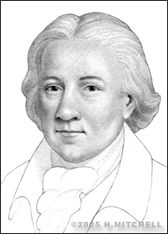Edmund Cartwright
British reverend, poet, and lifelong inventor Edmund Cartwright was born on April 24, 1743 in Marnham, Nottingham, England and would later invent a device that set in motion dramatic changes affecting today’s worldwide textile industry.
Cartwright’s parents were wealthy landowners in Marnham, and he and his four brothers were well educated. At least three of them would become well-renowned in their chosen professions. Edmund’s brother, John Cartwright, was a radical leader with England’s parliamentary reform movement at the turn of the century, and his brother George was a trader and explorer of Labrador.
Edmund Cartwright was himself a graduate of University College at Oxford. He pursued a master’s degree with Oxford’s Magdalen College, finishing his MA in 1766. From there, he became rector of a Leicestershire church, married, and continued to progress in his career with the church, taking on the curacy of Brampton in 1772, followed by his appointment as prebendary of Lincoln cathedral in 1786, a position he held for the rest of his life.
Meanwhile, Cartwright also published several acclaimed poems including “Armine and Elvira” and pursued an interest in engineering. It wasn’t until he was 40 years old that he began to take engineering and inventing seriously. In 1784, he embarked on a second career of sorts when he became very interested in industrial machinery. That year, he was invited to visit a factory owned by Richard Arkwright where he saw newly invented spinning machines turning cotton into thread at a rapid pace.
Arkwright had invented the spinning frame, or water frame, in 1769. Cartwright and some of his associates had earlier discussed the possibility that once Arkwright’s patents on these frames expired, many mills using his technology were likely to spring up, and much more thread would be produced quickly than could realistically be spun into cloth by human weavers.
Cartwright thought there had to be a way to make the weaving process automatic in order to keep pace. His colleagues didn’t believe it was possible, but with the help of a blacksmith and carpenter, he began working on a machine that would prove the doubters wrong. He created a prototype in 1785. His first version of the power loom was very basic, very crude, and did not perform very reliably. He obtained a patent on the machine, however, and pushed on.
By 1787, Cartwright had improved his loom concept, and he was issued several more patents on his designs until 1788. He opened his own weaving mill in Doncaster, using steam power, which was then a novelty, to drive the looms. One consequence of his invention was that human beings were no longer needed to perform some of the tasks the machine could do, and unfortunately, he realized he was suddenly putting a great number of people out of work. But it was too late to turn back time. Others saw what Cartwright had achieved and began building similar, and in many cases better, machines of their own, and the industry was changed forever.
Cartwright, meanwhile, proved a poor businessman. His looms operated well, but his mill eventually went out of business. He also faced hostility from threatened local textile workers, who are believed to have been responsible for a fire that destroyed 400 of his looms in a factory in Manchester in 1799.
Nonetheless, power looms began to take hold all over England with thousands of them operating all over the country by 1820. The American textile industry modified and adopted Cartwright’s original concept as well, with the first American-built power loom appearing in a factory in Massachusetts in 1813.
Cartwright moved on to other projects, including the invention and patenting of a wool-combing machine in 1790, a concept for interlocking bricks for construction in 1795, and an alcohol engine in 1797. That year, he also patented a fireproof flooring material made of fired clay. Later works included improvements to the steam engine and other modifications for engines and textile machinery.
Having moved to London in 1796, Cartwright never made much financial gain from his inventions. However, in 1809, after a group of textile manufacturers petitioned the House of Commons on his behalf, he was awarded 10,000 British pounds for his contributions to the British textile industry. He died in Kent on Oct. 30, 1823, at the age of 80.


